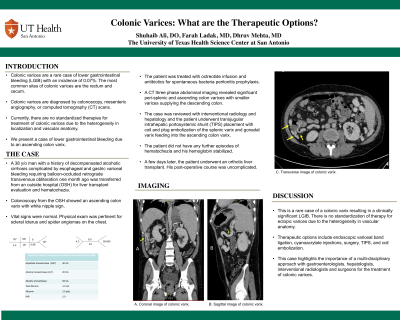Back


Poster Session A - Sunday Afternoon
Category: GI Bleeding
A0299 - Colonic Varices: What Are the Therapeutic Options?
Sunday, October 23, 2022
5:00 PM – 7:00 PM ET
Location: Crown Ballroom

Has Audio
.jpg)
Shuhaib S. Ali, DO
University of Texas Health San Antonio
San Antonio, TX
Presenting Author(s)
Shuhaib Ali, DO1, Farah H. Ladak, MD2, Dhruv Mehta, MD3
1University of Texas Health San Antonio, San Antonio, TX; 2University of Texas Health Science Center, San Antonio, TX; 3University of Texas Health Science Center , San Antonio, TX
Introduction: Colonic varices are a rare case of lower gastrointestinal bleeding (LGIB) with an incidence of 0.07%. The most common sites of colonic varices are the rectum and cecum. Colonic varices are diagnosed on colonoscopy, mesenteric angiography, or computed tomography (CT) scans. Currently, there are no standardized treatments for treatment of colonic varices due to the heterogeneity in localization and vascular anatomy. We present a case of LGIB due to an ascending colon varix.
Case Description/Methods: A 38 year-old-man with a history of decompensated alcoholic cirrhosis complicated by esophageal and gastric variceal bleed requiring balloon-occluded retrograde transvenous obliteration one month ago was transferred from an outside hospital (OSH) for liver transplant evaluation and hematochezia. He underwent a colonoscopy at the OSH which showed an ascending colon varix with white nipple sign. His vital signs were normal. His physical exam was benign except for scleral icterus with spider angiomas on his chest. His labs were pertinent for a hemoglobin of 8.0, hematocrit 24, platelet 50,000, alanine aminotransferase 50, total bilirubin 3.0, and international normalized ratio 2.0. The patient was treated with octreotide infusion and antibiotics for spontaneous bacterial peritonitis prophylaxis. A CT three phase abdominal imaging was revealed significant perisplenic and ascending colon varices with smaller varices supplying the descending colon. The case was reviewed with interventional radiology and hepatology and the patient underwent transjugular intrahepatic portosystemic shunt (TIPS) placement with coil and plug embolization of the splenic varix and gonadal varix feeding into the ascending colon varix. The patient did not have any further episodes of hematochezia and his hemoglobin stabilized. A few days later, the patient underwent an orthotic liver transplant. His post-operative clinical course was uncomplicated.
Discussion: This is a rare case of a colonic varix resulting in a clinically significant LGIB. There is no standardization of therapy for ectopic varices due to the heterogeneity in vascular anatomy. Therapeutic options include endoscopic variceal band ligation, cyanoacrylate injections, surgery, TIPS and coil embolization. This case highlights the importance of a multi-disciplinary approach with gastroenterologists, hepatologist, interventional radiologists, and surgeons for the treatment of colonic varices.
Disclosures:
Shuhaib Ali, DO1, Farah H. Ladak, MD2, Dhruv Mehta, MD3. A0299 - Colonic Varices: What Are the Therapeutic Options?, ACG 2022 Annual Scientific Meeting Abstracts. Charlotte, NC: American College of Gastroenterology.
1University of Texas Health San Antonio, San Antonio, TX; 2University of Texas Health Science Center, San Antonio, TX; 3University of Texas Health Science Center , San Antonio, TX
Introduction: Colonic varices are a rare case of lower gastrointestinal bleeding (LGIB) with an incidence of 0.07%. The most common sites of colonic varices are the rectum and cecum. Colonic varices are diagnosed on colonoscopy, mesenteric angiography, or computed tomography (CT) scans. Currently, there are no standardized treatments for treatment of colonic varices due to the heterogeneity in localization and vascular anatomy. We present a case of LGIB due to an ascending colon varix.
Case Description/Methods: A 38 year-old-man with a history of decompensated alcoholic cirrhosis complicated by esophageal and gastric variceal bleed requiring balloon-occluded retrograde transvenous obliteration one month ago was transferred from an outside hospital (OSH) for liver transplant evaluation and hematochezia. He underwent a colonoscopy at the OSH which showed an ascending colon varix with white nipple sign. His vital signs were normal. His physical exam was benign except for scleral icterus with spider angiomas on his chest. His labs were pertinent for a hemoglobin of 8.0, hematocrit 24, platelet 50,000, alanine aminotransferase 50, total bilirubin 3.0, and international normalized ratio 2.0. The patient was treated with octreotide infusion and antibiotics for spontaneous bacterial peritonitis prophylaxis. A CT three phase abdominal imaging was revealed significant perisplenic and ascending colon varices with smaller varices supplying the descending colon. The case was reviewed with interventional radiology and hepatology and the patient underwent transjugular intrahepatic portosystemic shunt (TIPS) placement with coil and plug embolization of the splenic varix and gonadal varix feeding into the ascending colon varix. The patient did not have any further episodes of hematochezia and his hemoglobin stabilized. A few days later, the patient underwent an orthotic liver transplant. His post-operative clinical course was uncomplicated.
Discussion: This is a rare case of a colonic varix resulting in a clinically significant LGIB. There is no standardization of therapy for ectopic varices due to the heterogeneity in vascular anatomy. Therapeutic options include endoscopic variceal band ligation, cyanoacrylate injections, surgery, TIPS and coil embolization. This case highlights the importance of a multi-disciplinary approach with gastroenterologists, hepatologist, interventional radiologists, and surgeons for the treatment of colonic varices.
Disclosures:
Shuhaib Ali indicated no relevant financial relationships.
Farah Ladak indicated no relevant financial relationships.
Dhruv Mehta indicated no relevant financial relationships.
Shuhaib Ali, DO1, Farah H. Ladak, MD2, Dhruv Mehta, MD3. A0299 - Colonic Varices: What Are the Therapeutic Options?, ACG 2022 Annual Scientific Meeting Abstracts. Charlotte, NC: American College of Gastroenterology.
